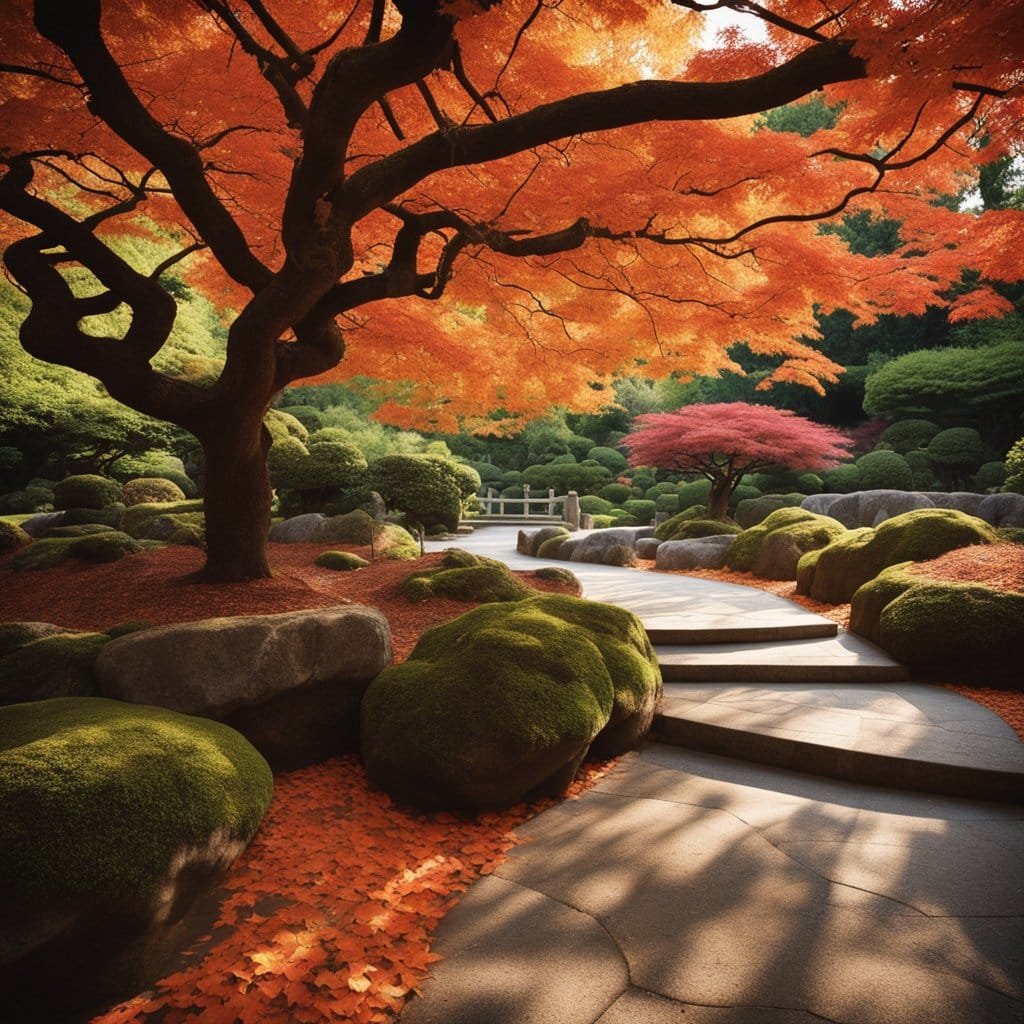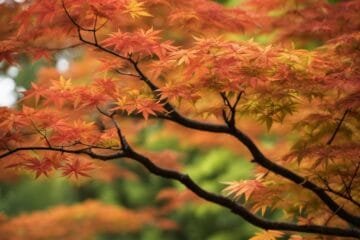
Japanese Maples: The Complete Guide
Japanese maples are admired for their striking beauty and variety. These trees add vibrant colors and unique textures to gardens. With their delicate leaves and elegant branching, they are a favorite among gardeners and landscape designers alike.

Japanese maples thrive in a variety of settings and can be grown in different climates. Whether it’s a small courtyard or a spacious yard, these trees can be an enchanting addition to any landscape. Careful cultivation and care, including the right watering and pruning techniques, ensure these trees maintain their splendor year-round.
Incorporating Japanese maples into garden design offers endless possibilities. Their seasonal color changes, ranging from deep reds to bright yellows, create an ever-changing backdrop. Each variety has unique characteristics, making them a versatile choice for any garden enthusiast seeking to create a serene and visually appealing outdoor space.
Key Takeaways
- Japanese maples are versatile and thrive in various climates.
- Proper care keeps Japanese maples beautiful all year.
- Varieties offer unique features for diverse garden designs.
Varieties and Classification
Japanese maples come in a variety of species and cultivars, each with unique characteristics. Some are known for their vibrant foliage, while others are recognized for their growth habits. Understanding these differences is essential for anyone interested in these beautiful trees.
Distinguishing Between Species
Japanese maples are primarily divided into three species: Acer palmatum, Acer japonicum, and Acer shirasawanum. Acer palmatum is the most common and includes many popular varieties. It typically features deeply lobed leaves and can vary in size and color.
Acer japonicum, often called the full-moon maple, is known for its rounded leaves and excellent fall color. It thrives in cooler climates and provides a striking display each autumn.
Acer shirasawanum, another notable species, often has similar characteristics to Acer japonicum and is appreciated for its unique leaf shapes and vibrant hues. These species may vary in their preferred growing conditions, such as sunlight and soil requirements.
Popular Cultivars
Several cultivars stand out due to distinctive features. ‘Bloodgood’ is a well-loved Acer palmatum known for its dark red foliage that holds color throughout the growing season.
The ‘Crimson Queen’ is a variety with a weeping form and lacy leaves, making it a popular choice for ornamental gardens. Another unique cultivar is the ‘Coonara Pygmy’, which originated from a mutation and is recognized for its compact size and bright foliage.
‘Red Dragon’ is valued for its deep red leaves that maintain their color even in shade. Lastly, the ‘Wolff’ variety, which is another name for Bloodgood, is noted for its hardiness and adaptability, making it a favorite in various landscapes. These cultivars highlight the diversity and appeal of Japanese maples.
Cultivation and Care
Japanese maples are popular for their striking fall foliage and versatile growth forms. Successful growth involves attention to planting techniques, soil conditions, watering, feeding, and careful pruning to maintain health and appearance.
Proper Planting Techniques
Japanese maples thrive when planted in well-drained soil, with careful attention to the site. The chosen location should provide partial shade to prevent leaf scorch. Dig a hole slightly wider and as deep as the pot.
Steps:
- Remove the tree from its pot gently.
- Place in the hole at the same depth.
- Backfill with soil, being sure to eliminate air pockets by firming it down.
Japanese maples can be effectively used in container planting. Choose a container with good drainage, and monitor water needs closely, especially during hot weather. Cultivars like ‘Autumn Moon’ are suitable for this method due to their more compact growth rate.
Soil and Mulching
Japanese maples prefer acidic soil with a pH between 5.5 and 6.5. Enrich the soil with organic matter like compost to provide nutrients and improve drainage.
Mulching:
Mulch around the base helps to retain moisture and keep roots cool. Choose organic materials such as bark or leaf mold. Apply a layer about 2-3 inches thick, keeping it away from the trunk to prevent rot and disease. This practice not only supports growth but also enhances the overall appearance of the planting area.
Watering and Feeding
Regular water is essential for Japanese maple trees, especially in dry periods. Deep watering encourages strong root development.
- Amount: Water once or twice a week during active growth, allowing the soil to dry slightly between sessions.
- Feeding: Apply a balanced, slow-release fertilizer in early spring. This feeds the tree throughout the growing season. Avoid over-fertilizing, as it can encourage diseases and unwanted growth.
Container-grown maples may require more frequent watering due to faster evaporation. Monitoring for signs of stress, such as wilting or leaf scorch, helps maintain tree health.
Pruning and Shaping
Pruning is crucial for shaping and maintaining the health of Japanese maples. Prune in late winter or early spring when the tree is dormant.
Techniques:
- Remove dead, crossing, or diseased branches.
- For more light and air circulation, thin out dense areas.
- To promote a desired shape, especially in bonsai or specific cultivars like the ‘Coral Bark Maple’, carefully trim outer branches.
Regular pruning enhances fall foliage and prevents potential damage from strong winds or heavy snow. Avoid heavy pruning in the growing season to reduce stress and risk of disease.
Designing with Japanese Maples
Japanese maples are versatile trees that add beauty through their colorful foliage and unique forms. They are popular choices in garden design for both small and large spaces. Whether used as standalone specimens or combined with other plants, Japanese maples bring elegance to any garden.
Landscape Use and Complementary Plants
In garden design, Japanese maples can serve as stunning focal points due to their vibrant colors and varied leaf shapes. With sizes ranging from dwarf varieties to larger specimens, these small trees fit well in various landscapes. When considering garden placement, it’s important to note their seasonal color changes, which can be showcased alongside plants like azaleas and rhododendrons.
Complementary plants such as azaleas and rhododendrons enhance the appeal of Japanese maples. Their flowering periods provide contrast and interest throughout different seasons. Proper planting ensures that both the maple and its surrounding plants thrive. Selecting plants with varied textures and heights can highlight the maple’s elegant form, creating a harmonious and colorful garden setting.
Seasonal Changes and Color
Japanese maples present a magnificent display throughout the year, captivating enthusiasts with their vibrant leaf colors and unique foliage transformations. Each season brings different visual delights, such as bright spring growth, vivid fall colors, and intriguing winter bark characteristics.
Spring and Summer Growth
In spring, Japanese maples showcase a delightful burst of color. The leaves unfurl in stunning shades ranging from golden-orange to vibrant red, depending on the variety. For example, the Acer palmatum ‘Katsura’ has golden-orange leaves with pink edges as they emerge. These lively hues transition to various summer tones like green or deep purple.
Regular watering and light fertilization help maintain healthy foliage during the growing season. Mulching around the base conserves moisture and supports root health. Pruning is minimal in these months, focusing on shaping the trees and removing any crossing branches.
Autumn Brilliance
Autumn is when Japanese maples are truly spectacular. The trees transition into vibrant fall colors, including shades of orange, yellow, and fiery red. The changing foliage enriches any landscape, making these trees a popular choice. One standout variety is the Acer palmatum ‘Amber Ghost’, known for its vivid transformation in the fall.
Mulching also aids in foliage color development by maintaining consistent soil temperature and moisture. As deciduous trees, they shed leaves, which can create a beautiful, colorful carpet beneath them. It’s also a traditional pastime in Japan to admire these autumn colors, often referred to as “momiji-gari”.
Winter Interest
Even after the leaves have fallen, Japanese maples continue to captivate with their winter interest. The Coral Bark Japanese Maple is particularly noteworthy for its bright red bark, which stands out against the winter landscape. This colorful bark adds visual interest even when foliage is absent.
While these trees are generally hardy, some varieties may need winter protection from harsh conditions. Applying mulch to insulate the roots and wrapping younger trees with burlap can prevent damage. Regularly checking for pests or diseases can ensure they stay healthy through the colder months. This careful attention helps protect their beauty and ensures robust growth come spring.
Japanese Maples: Expert Tips for Thriving Gardens
Frequently Asked Questions
Japanese maples are known for their stunning foliage and ornamental beauty. They require specific care strategies depending on their type and potential issues such as diseases or site conditions.










